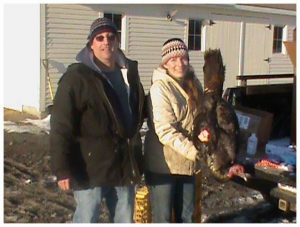Researchers Find Mysterious Pathogen in Maine’s Wild Turkeys
 Evidence of pathogens in Maine’s wild turkey population, including a low pathology cancer-causing retrovirus found in a large percentage of birds, has been documented by researchers at the University of Maine Augusta (UMA) and the Maine Department of Inland Fisheries and Wildlife (DIFW)
Evidence of pathogens in Maine’s wild turkey population, including a low pathology cancer-causing retrovirus found in a large percentage of birds, has been documented by researchers at the University of Maine Augusta (UMA) and the Maine Department of Inland Fisheries and Wildlife (DIFW)
The research team, which was part of the five-year Sustainability Solutions Initiative (SSI) based at the Senator George J. Mitchell Center at UMaine, collected samples from feces, carcasses, and live birds around the state. In addition to the avian pox retrovirus (LPDV), the team isolated Staphylococcus bacteria, including Methicillin-resistant Staphylococcus aureus (MRSA), a strain of bacteria that’s become resistant to the antibiotics commonly used to treat ordinary staph infections.
“There were no wild turkeys in Maine for 30 years and they were successfully repopulated. Now we are looking at widespread LPDV in this population. Evidence of viral DNA has been found in birds located all over the state and we don’t yet know what that means,” said Peter Milligan, Associate Professor of Biology at UMA.
Milligan and colleagues examined the biology, genetics, and distribution of wild turkeys throughout the state to get a clearer picture of the birds’ actual and potential effects on Maine agriculture. Additionally, the team has spoken with farmers, sport hunters, outdoor enthusiasts, community members, and other stakeholders to gain an understanding of wild turkey acceptance. Team members include: Christopher Lage, Associate Professor of Biology at UMA; Catherine Turcotte, Assistant Professor of Sociology at Colby-Sawyer College; Joseph Szakas, Vice President for Academic Affairs and Provost at UMA.
The big question: could the wild turkey population transfer pathogens to domestic turkeys and other avian livestock in the state? LPDV, which was not detected in the U.S. before 2009, is the main concern. Birds infected with LPDV may develop tumors on their heads, necks and legs. Although the extent of the pathogen’s threat is not yet known, the data collected by Milligan and a team of undergraduates led the DIFW to temporarily halt wild turkey relocation-repopulation programs.
“People want to know if the genes for the retrovirus are in domestic livestock,” Milligan said. “We’re seeing a high rate of infection in the wild population, so the question becomes: is it only in wild birds and if so how does that impact livestock practices.”
Working with vets across the state, Milligan said he has yet to locate a domestic bird infected with LPDV, though only about 20 have been tested so far. The researchers’ work on LPDV was featured on the National Science Foundation’s (NSF) website in the Science, Engineering & Education Innovation section which highlights NSF-funded projects that are advancing knowledge.
Milligan says other bacterial pathogens detected, such as antibiotic resistant MRSA, are also being studied to determine if these strains are similar to those that impact the human population.
Collaborators on the project include; Ann Lichtenwalner, Associate Professor and Director, UMaine’s Animal Health Laboratory; Kelsey Sullivan and Brad Allen, Maine Department of Inland Fisheries and Wildlife; Charles Lubelczyk, Maine Medical Center Research Institute and Justin Brown, Wildlife Veterinarian for the Pennsylvania Wildlife Commission.
Supported by National Science Foundation award EPS-0904155 to Maine EPSCoR at the University of Maine.
